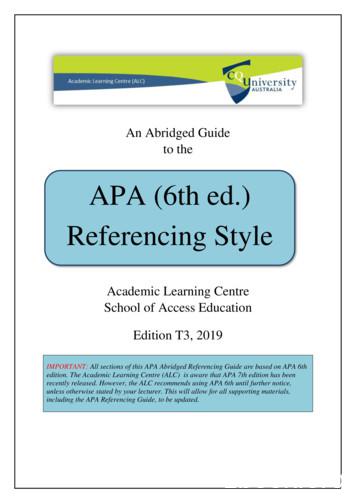APA 6th Style For Referencing - LSE Home
A short guide toAPA 6th style for referencingLSE LibraryMay 2016Page 1 of 8
APA 6th style for referencingContent1. In-text citations. 22. Reference list . 33. Further help . 44. Examples of how to reference different sources . 5This short guide explains how to cite some of the major types of materials you arelikely to use in your academic writing. The American Psychological Associationreferencing style (APA) is an author-date in-text method of citation (also known asthe Harvard method, but not the same as the Harvard style). The 6th and latestedition was published in 2010.1. In-text citations These appear in the body of your work. APA style uses the author-date method of referencing. In-text citations will mostly appear in the following format:(author’s last name, year of publication, page numbers if needed)E.g. In the 1980’s sales of blue jeans slowed and then declined (Smith,2014). You can also include the author’s name in a sentence, leaving it out from thebrackets:E.g. According to Smith (2014, p. 125) the sales. Page numbers – use p. for one page and pp. for multiple pages.E.g. (Smith, 2014, pp. 45-49) Secondary referencingWhen citing a source you have not read yourself, but which was mentioned in asource you have read, use the following format:E.g. Brown (as cited in Smith, 2014, p. 35) argues that Reference Smith, not Brown, in the reference list.It is always preferred to cite the original source. Three or more authorsThe first time you cite the source, list all the authors. Use the word "and" betweenthe authors' names within the text and use “&” in the parentheses.E.g. (Kernis, Cornell, Sun, Berry, & Harlow, 1993)Smith, Brown and Turner (2003) state that LSE LibraryPage 2 of 8
APA 6th style for referencingIn subsequent citations, only use the first author's last name followed by "et al." inthe text or parentheses.E.g. (Kernis et al., 1993)Smith et al. (2003) argued All names must be included in the reference list. QuotesWhen quoting from a source, you must include page number(s) and enclose thequote in phrase marks.E.g. According to Jones (1998), "Students often had difficulty using APAstyle, especially when it was their first time" (p. 199).She stated, "Students often had difficulty using APA style" (Jones, 1998, p.199), but she did not offer an explanation as to why.Long quotes should be presented in your work as a block, indented from the left,with a space above and below the quote, without quotation marks.E.g. It has been argued that:The effectiveness of celebrities as communications sourcesoften depends upon their perceived credibility. Consumers maynot trust a celebrity’s motives for endorsing a product or theymay question the star’s competence to evaluate the product’sclaims (Solomon et al. 2006, p.177).This . More than one sourceList sources alphabetically by surname in the in-text citation in the order in whichthey appear in the reference list, separating them with a semicolon.E.g. The cyclical process (Carr & Kemmis, 1986; Dick, 2000; Kemmis &McTaggart, 1988; MacIsaac, 1995) suggests 2. Reference list The reference list should appear at the end of your work on a separate page. Only include references you have cited in your work. All references should have a hanging indent, meaning that all lines of a referencesubsequent to the first line should be indented.E.g. Easton, B. (2008). Does poverty affect health? In K. Dew & A.Matheson (eds.), Understanding health inequalities inAotearoa New Zealand (pp. 97-106). Dunedin, New Zealand:Otago University Press. References should be listed alphabetically by the last name of the first author ofeach work.LSE LibraryPage 3 of 8
APA 6th style for referencing Special cases: For works by different authors with the same family name, list referencesalphabetically by the authors’ initials. For multiple works by the same author in different years, list referenceschronologically (earliest to latest). For multiple works by the same author in the same year, list referencesalphabetically by title in the reference list.E.g. Alleyne, R.L. (2001). Alleyne, R.L., & Evans, A.J. (1999). Baheti, J.R. (2001a). Baheti, J.R. (2001b). Cabading, J.R., & Wright, K. (2000). Cabading, J.R., & Wright, K. (2001). Garofalo, R. (1992). .Garofalo, R. (Ed.). (1988). The London School of Economics and Political Science. (2005). Mathur, A.L., & Wallston, J. (1999). Mathur, S.E., & Ahlers, R.J. (1998). Panorama. (2003). When referring to Books, Book Chapters, Article Titles or Webpages, capitaliseonly the first letter of the first word of a title and subtitle, and proper nouns.E.g. Agricultural investment and productivity: Building sustainability in EastAfrica When referring to Journal Titles, capitalise all major words (do not capitalisewords such as ‘of’, ‘and’, & ‘the’ unless they are the first word in the title).E.g. International Journal of Development and Sustainability EBooks – cite the same as print books. Online journal articlesFor pdf files, cite them as print articles.If a DOI (permanent digital object identifier) is provided, always include it in yourreference.3. Further helpFor further help, please get in touch with your department’s Academic arianLSE LibraryPage 4 of 8
APA 6th style for referencing4. Examples of how to reference different sourcesReference listIn-text citationOne authorPilger, J. (2006). Freedom next time. London, England: Bantam.(Pilger, 2006) or Pilger (2006) Multiple authorsAlred, G. J., Brusaw, C. T., & Oliu, W. E. (2009). The businesswriter’s handbook. New York, NY: St Martin’s Press.Firstcitation:(Alred, Brusaw, & Oliu,2009)Subsequentcitations:(Alred et al., 2009)BOOKSEdition other than firstFirstHelfer, M. E., Kempe, R. S., & Krugman, R. D. (1997). Thebattered child (5th ed.). Chicago, IL: University of Chicago citation:Press.Subsequentcitations:Helfer, Kempe andKrugman (1997)demonstrated that Helfer et al. (1997)argued Chapter in edited bookEaston, B. (2008). Does poverty affect health? In K. Dew & A.Matheson (Eds.), Understanding health inequalities inAotearoa New Zealand (pp. 97-106). Dunedin, NewZealand: Otago University Press.(Easton, 2008)Edited bookGarafalo, R. (Ed.). (1992). Rockin' the boat: Mass music andmass movements. Boston, MA: South End Press.(Garafalo, 1992)Translated bookLaplace, P. S. (1951). A philosophical essay on probabilities. (F. (Laplace, 1814/1951)W. Truscott & F. L. Emory, Trans.). New York, NY: Dover.(Original work published 1814).LSE LibraryPage 5 of 8
APA 6th style for referencingJOURNAL ARTICLEOnline articleWith DOI (DigitalObject Identifier)Print or no DOILi, S., & Seale, C. (2007). Learning to do qualitative dataanalysis: An observational study of doctoral work.Qualitative Health Research, 17, 1442-1452.doi:10.1177/1049732307306924Li and Seale (2007) Patton, M. (1997). Evaluation as a tool. Journal of SocialScience, 18(3), 345-356.(Patton, 1997, p. 347)or (Li & Seale, 2007)LEGISLATION (for non-legal purposes)ActN/A – not recorded in the reference listChildren Act 1989 or According to s.1 of the Children Act1989 BillN/A – not recorded in the reference listChildren (Access to Parents) HC Bill(2012-13) [33]Law report (case)N/A – not recorded in the reference listFirstcitation:(Chalmers v. Johns[1999] 1 FLR 39)Subsequentcitations:(Chalmers v. Johns,1999)NEWSPAPER ARTICLENewspaper articleNo author - onlineSmith, T. (2003, June 23). University tuition fees: The debate.The Guardian, p. 16.(Smith, 2003, p. 16)Nuke test inquiry doubted. (2009, April 23). The Dominion Post,p. 5. Retrieved from http://www.stuff.co.nz/dominion-post/(Nuke test inquiry doubted, 2009)LSE Libraryor Smith (2003, p. 16)Page 6 of 8
APA 6th style for referencingOFFICIAL PUBLICATIONSWith reference number Department for Children, Schools and Families. (2009). Theprotection of children in England: Action plan: theGovernment's response to Lord Laming (Cm 7589).London, England: The Stationery nt forChildren, Schools andFamily [DCSF], 2009)(DCSF, 2009)Harris, J., & Grace, S. (1999). A question of evidence?Investigating and prosecuting rape in the 1990s (HomeOffice Research Study 196). Retrieved ris & Grace, 1999)Blog postFreakonomics. (2010, October 29). E-ZPass is a life-saver(literally) [Blog post]. Retrieved 29/ezpass-is-a-life-saver-literally/(Freakonomics, 2010)Web documentSimon, J., Smith, K., & West, T. (2009). Price incentives andconsumer payment behaviour. Retrieved RDP/RDP2009-04.html(J. Smith, K. Smith & West, 2009)Website – no dateThe College of William and Mary. (n.d.). College missionstatement. Retrieved from sion/index.php(The College of William and Mary, n.d.)Website – no authorAll 33 Chile miners freed in flawless rescue. (2010). Retrievedfrom http://www.msnbc.msn.com/id/39625809/ns/world news-americas/(All 33 Chile miners freed in flawlessrescue, 2010, para 5) or Online governmentreportWEB PAGESLSE Libraryin All 33 Chile miners freed in flawlessrescue (2010, para 5) Page 7 of 8
APA 6th style for referencingWebsite – corporateauthor, no dateBritish Psychological Association. (n.d.). How can psychologyhelp you. Retrieved ritish Psychological Association, n.d.,para 5)Business reportFAME. (2010). Company Report of Tesco PLC. Retrieved fromhttp://fame.bvdep.com(FAME, 2010)Conference paper publishedSecker, J. (2005). Current issues in information literacy: Are wemaking all the wrong assumptions? In A. Martin (Ed.)(2006). Proceedings of the 4th eLiteracy Conference,June 15-17, 2005 (pp. 23-25). Glasgow, Scotland:University of Strathclyde.(Secker, 2005)DataMintel. (2011). Coffee in China. Retrieved from Mintel GlobalMarkets Navigator. http://gmn.mintel.com/navigate/(Mintel, 2011))Lecture notesAcemoglu, D. (2004). Understanding institutions. [PowerPointslides]. Retrieved fromhttp://cep.lse.ac.uk/events/lectures/23022004 daron acemoglu.ppt(Acemoglu, 2004)PersonalcommunicationN/A – not recorded in the reference listJ. Secker (personal communication,June 6, 2015)Thesis/DissertationKardefelt Winther, D. (2014) Excessive internet use: Fascinationor compulsion? (Unpublished doctoral thesis). LondonSchool of Economics and Political Science, London.(Kardefelt Winther, 2014)OTHERAF May 2016LSE LibraryPage 8 of 8
referencing style (APA) is an author-date in-text method of citation (also known as the Harvard method, but not the same as the Harvard style). The 6th and latest edition was published in 2010. 1. In-text citations These appear in the body of your work. APA style uses the author-date method of referencing.
Kenya Methodist University Guide to APA Referencing Style 5 Referencing & APA style Referencing Referencing is acknowledging the ownership of resources used in your academic writing, and providing information necessary to identify and retrieve the work cited
Wintec APA Guide Page 1 of 7 Revised June 2015 APA Referencing (6th edition) This is the Wintec guide to help you with referencing in the American Psychological Association (APA) style. For further information, please refer to the 6th edition of The Publication Manual of the American Psychological Association (2010), or see a staff member in the Library, Student Learning Services or Te Kete .
Edition T3, 2019 IMPORTANT: All sections of this APA Abridged Referencing Guide are based on APA 6th edition. The Academic Learning Centre (ALC) is aware that APA 7th edition has been recently released. However, the ALC recommends using APA 6th until further notice, unless otherwise stated by your lecturer.
APA style APA style blog APA (7th ed.) Quick Reference Guide 1. For APA referencing subjects, APA requires page or paragraph numbers for in-text references for ALL direct quotations in assignments. Check with your unit coordinator if you are unsure. 2. For Business & Linguistics units, use page numbers for ALL direct quotations AND paraphrases.
A guide to APA referencing – 6th edition 7 The following guide provides some general rules and examples using the 6th ed. of APA. For further information and help: Refer to the Publication manual of the American Psychological Association (6th ed.) [from here on referred to as the APA manual], especially chapters 6 & 7.
There are subtle differences between the 6th and 7th editions of the APA referencing style. The following table presents the most salient features ‘at a glance’: APA 6th edition APA 7th edition Use of ‘et al.’ in-text The 6th edition permits the use of et al. when citing four or more authors/editors in- text. If the source
Student Success Page A Guide to APA 6th ed. Referencing Style 6 of 35 Refer to the Publication manual of the American Psychological Association (6th ed.) [from here on referred to as the APA manual], especially chapters 6 & 7. Copies are available at the UCOL Library, some for borrowing, some on Desk reserve.
b. What is AngularJS? 2. Basic Angular Security Concepts a. Strict Contextual Auto Escaping b. The HTML Sanitizer 3. Common Security pitfalls a. Server-Side Template Injection b. Client-Side Template Injection c. Converting strings to HTML d. White- and Blacklisting URLs 4. Conclusion Agenda























